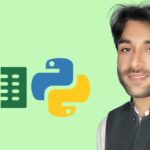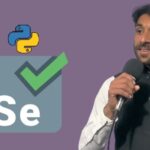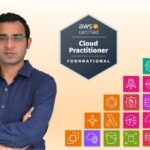
NLP Interview Questions and Solutions Preparation Observe Take a look at | Freshers to Skilled | Detailed Explanations
What you’ll study
Perceive elementary NLP ideas similar to tokenization and phrase embeddings.
Develop abilities in textual content preprocessing and have engineering for NLP duties.
Grasp a wide range of NLP fashions, from conventional algorithms to state-of-the-art deep studying architectures.
Observe with interview-style questions overlaying each foundational ideas and superior subjects in NLP.
Description
NLP Interview Questions and Solutions Preparation Observe Take a look at | Freshers to Skilled
Welcome to the final word apply take a look at course for mastering Pure Language Processing (NLP) interview questions. Whether or not you’re making ready for a job interview or trying to improve your information in NLP, this complete course is designed that can assist you ace your interviews with confidence.
On this course, we cowl six important sections, every specializing in key ideas and methods within the discipline of NLP. From foundational ideas to superior purposes, you’ll achieve a deep understanding of NLP and develop the abilities wanted to deal with interview questions successfully.
Part 1: Foundations of NLP On this part, you’ll dive into the basic ideas that type the spine of NLP. From tokenization to phrase embeddings, you’ll discover the constructing blocks of pure language processing and perceive how textual content knowledge is processed and represented.
- Tokenization: Discover ways to break down textual content into particular person tokens or phrases.
- Stemming vs. Lemmatization: Perceive the variations between stemming and lemmatization and when to make use of every method.
- Half-of-Speech (POS) Tagging: Discover easy methods to assign grammatical classes to phrases in a sentence.
- Named Entity Recognition (NER): Uncover methods for figuring out and classifying named entities similar to individuals, organizations, and areas.
- Cease Phrases Elimination: Discover ways to filter out widespread phrases that carry little semantic that means.
- Phrase Embeddings: Discover strategies for representing phrases as dense vectors in a steady area.
Part 2: Textual content Illustration and Function Engineering This part focuses on completely different approaches for representing textual content knowledge and extracting related options for NLP duties.
- Bag-of-Phrases mannequin: Perceive easy methods to symbolize textual content knowledge as a set of phrase vectors.
- TF-IDF (Time period Frequency-Inverse Doc Frequency): Be taught a statistical measure for evaluating the significance of phrases in a doc corpus.
- Word2Vec: Discover a preferred phrase embedding method based mostly on neural networks.
- GloVe (World Vectors for Phrase Illustration): Perceive how GloVe embeddings seize international phrase co-occurrence statistics.
- Character-level Embeddings: Uncover methods for representing phrases on the character stage.
- Doc Embeddings: Discover ways to generate embeddings for complete paperwork utilizing methods like Doc2Vec.
Part 3: NLP Fashions and Algorithms This part covers a spread of NLP fashions and algorithms generally used for duties similar to classification, sequence labeling, and language technology.
- Naive Bayes Classifier: Discover a easy but efficient probabilistic classifier for textual content classification duties.
- Assist Vector Machines (SVM): Perceive how SVMs can be utilized for textual content classification and sentiment evaluation.
- Hidden Markov Fashions (HMM): Study HMMs and their purposes in duties like part-of-speech tagging and named entity recognition.
- Conditional Random Fields (CRF): Discover a discriminative mannequin used for sequence labeling duties.
- Recurrent Neural Networks (RNNs): Perceive how RNNs can seize sequential dependencies in textual content knowledge.
- Transformer Fashions: Dive into superior fashions like BERT and GPT for duties similar to language understanding and technology.
Part 4: Syntax and Parsing On this part, you’ll study concerning the syntactic construction of sentences and methods for parsing and analyzing textual content.
- Context-Free Grammars (CFG): Perceive the formal grammar guidelines used to generate syntactically legitimate sentences.
- Dependency Parsing: Discover ways to parse sentences to establish the grammatical relationships between phrases.
- Constituency Parsing: Discover methods for breaking down sentences into their constituent phrases.
- Shallow Parsing (Chunking): Uncover strategies for figuring out and extracting particular forms of phrases from textual content.
- Parsing Methods: Study algorithms just like the Earley Parser and CYK Algorithm used for syntactic parsing.
- Transition-based vs. Graph-based Parsing: Evaluate completely different approaches to parsing based mostly on transition methods and graph algorithms.
Part 5: Semantic Evaluation This part focuses on understanding the that means of textual content and extracting semantic info for numerous NLP duties.
- Semantic Position Labeling (SRL): Discover methods for figuring out the roles performed by completely different entities in a sentence.
- Phrase Sense Disambiguation (WSD): Discover ways to disambiguate the that means of phrases based mostly on context.
- Semantic Similarity Measures: Perceive strategies for quantifying the similarity between phrases or sentences.
- Semantic Parsing: Discover methods for changing pure language utterances into formal representations like logical varieties.
- Sentiment Evaluation: Discover ways to analyze the sentiment expressed in textual content knowledge, starting from optimistic to adverse.
- Coreference Decision: Uncover methods for resolving references to entities throughout a number of sentences or paperwork.
Part 6: Purposes and Superior Matters On this remaining part, you’ll discover real-world purposes of NLP and delve into superior subjects shaping the way forward for the sphere.
- Machine Translation: Study methods for translating textual content from one language to a different.
- Textual content Summarization: Discover strategies for routinely producing concise summaries of longer texts.
- Query Answering Programs: Perceive how NLP fashions can be utilized to reply questions posed in pure language.
- Pure Language Era (NLG): Discover ways to generate human-like textual content based mostly on structured knowledge or prompts.
- Dialogue Programs: Discover the design and implementation of conversational brokers, often known as chatbots.
- Moral Concerns in NLP: Focus on the moral challenges and issues concerned in growing and deploying NLP methods.
Enroll on this apply take a look at course in the present day and take your NLP interview preparation to the following stage. With a complete overview of key ideas, hands-on apply questions, and detailed explanations, you’ll be well-equipped to excel in any NLP interview setting. Whether or not you’re a seasoned skilled or simply beginning your NLP journey, this course will present invaluable insights and preparation methods that can assist you succeed. Don’t miss out on this chance to grasp Pure Language Processing and land your dream job within the discipline. Enroll now and begin your journey in the direction of NLP excellence!
Content material
The publish 600+ NLP Interview Questions Observe Take a look at appeared first on destinforeverything.com/cms.
Please Wait 10 Sec After Clicking the "Enroll For Free" button.








